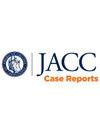Imaging Pitfalls in the Detection of Infiltrative Cardiomyopathies
Q4 Medicine
引用次数: 0
Abstract
Background
Despite increasing recognition of infiltrative cardiomyopathies, the heterogeneous group of diseases remains difficult to diagnose.
Case Summary
We present an 82-year-old man with septal basal thickening initially thought to be hypertrophic cardiomyopathy. Further imaging was suspicious for sarcoidosis, but after several years without clinical improvement and the interval development of concentric hypertrophy, he was diagnosed with cardiac amyloidosis.
Discussion
Advanced imaging modalities are frequently used to evaluate suspected infiltrative cardiomyopathies. However, the effectiveness of imaging can be limited by the variable presentations of both sarcoid and amyloid. In this case, cardiac amyloidosis initially appeared on imaging with features characteristic of cardiac sarcoidosis on both positron emission tomography and cardiac magnetic resonance. Despite advancements in imaging technology, diagnostic limitations persist, potentially leading to misdiagnosis and delayed treatment.
Take-Home Messages
Despite increasing recognition, cardiac amyloid and cardiac sarcoid are difficult to diagnose and require a high degree of clinical suspicion. Multimodality imaging can help discriminate between cardiomyopathies. However, limitations with current imaging modalities may lead to further diagnostic uncertainty.
浸润性心肌病检测中的影像学缺陷
背景:尽管越来越多的人认识到浸润性心肌病,但异质组的疾病仍然难以诊断。病例总结:我们报告一名82岁男性室间隔基底增厚,最初被认为是肥厚性心肌病。进一步的影像学检查怀疑为结节病,但数年未见临床改善,间隔期发展为同心性肥厚,最终诊断为心脏淀粉样变。先进的成像模式经常用于评估疑似浸润性心肌病。然而,成像的有效性可能受到肉瘤和淀粉样蛋白的不同表现的限制。本例中,心脏淀粉样变最初出现在影像上,在正电子发射断层扫描和心脏磁共振上均表现为心脏结节病的特征。尽管成像技术取得了进步,但诊断局限性仍然存在,这可能导致误诊和延误治疗。尽管越来越多的人认识到,心脏淀粉样蛋白和心脏肉瘤很难诊断,需要高度的临床怀疑。多模态成像有助于区分心肌病。然而,当前成像方式的局限性可能导致进一步的诊断不确定性。
本文章由计算机程序翻译,如有差异,请以英文原文为准。
求助全文
约1分钟内获得全文
求助全文
来源期刊

JACC. Case reports
Medicine-Cardiology and Cardiovascular Medicine
CiteScore
1.30
自引率
0.00%
发文量
404
审稿时长
17 weeks
 求助内容:
求助内容: 应助结果提醒方式:
应助结果提醒方式:


